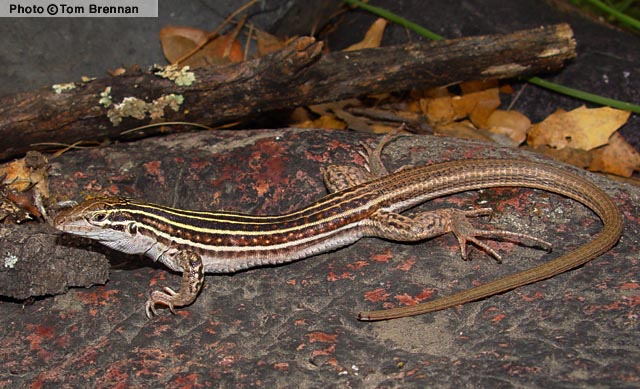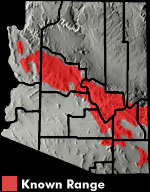Online Field Guide to The Reptiles and Amphibians of Arizona



Gila County, AZ
| GILA SPOTTED WHIPTAIL Aspidoscelis flagellicauda | |
|
DESCRIPTION: A medium-sized (up to 99 mm or 3.9″ from snout to vent), slim, brown to black lizard with a long, thin tail, and a slim, pointed snout. The body is marked with six light yellow or cream stripes and relatively few light spots. The light spots are visible between and within the stripes. The tail is olive to blue-brown. The underside is plain and pale. Juveniles lack spots. The scales on the body are small and granular. The scales on the tail are large, keeled, and rectangular. The belly scales are large, smooth, and rectangular and the scales on top of the head are large, smooth, and plate-like. The Gila Spotted Whiptail’s distinct stripes (particularly on the neck) and relatively spare spotting distinguish it from the similar looking Chihuahuan Spotted Whiptail. HABITAT: Primarily an inhabitant of Great Basin Conifer Woodland, Interior Chaparral, and Madrean Evergreen Woodland communities. Its range also extends into the lower reaches of Petran Montane Conifer Forest and follows drainages and riparian corridors down into Semidesert Grassland. Usually found in relatively open and sunny areas, often along the banks of creeks and rivers. BEHAVIOR: This is an alert, diurnal, fast-moving ground-dweller. It is often encountered foraging or basking in the mid-morning sun. It hibernates during fall and winter. DIET: It actively forages for a variety of insects and spiders by rooting around in organic matter under bushes and digging in the soil around the bases of rocks, and other surface debris. REPRODUCTION: All Gila Spotted Whiptails are female (parthenogenetic). Eggs are unfertilized and hatchlings are clones of the mother. Clutches of 2 to 6 eggs are laid in late spring or summer. By Thomas C. Brennan Brennan, T. C., & A. T. Holycross. 2006. A Field Guide to Amphibians and Reptiles in Arizona. Arizona Game and Fish Department. Phoenix, AZ Brennan, T. C., & A. T. Holycross. 2005. A Field Guide to Amphibians and Reptiles of Maricopa County. Arizona Game and Fish Department. Phoenix, AZ Stebbins, R.C. 2003. A Field Guide to Western Reptiles and Amphibians, Third Edition. Houghton Mifflin Company, Boston, MA. |
 |
Visit Partners in Amphibian and Reptile Conservation:


HOME
Copyright © 2023, Arizona Game and Fish Department. All rights reserved.
If you make use of the textual contents of this site in reports, publications, etc. please cite and credit the author(s) and photographer(s). All photos on this website are copyrighted. However, those found in the species account section may be used for any noncommercial scientific, educational, or conservation purposes provided that photographs are not altered and continue to bear the copyright symbol and name of the photographer. Please contact the photographer regarding commercial use of copyrighted photographs.









